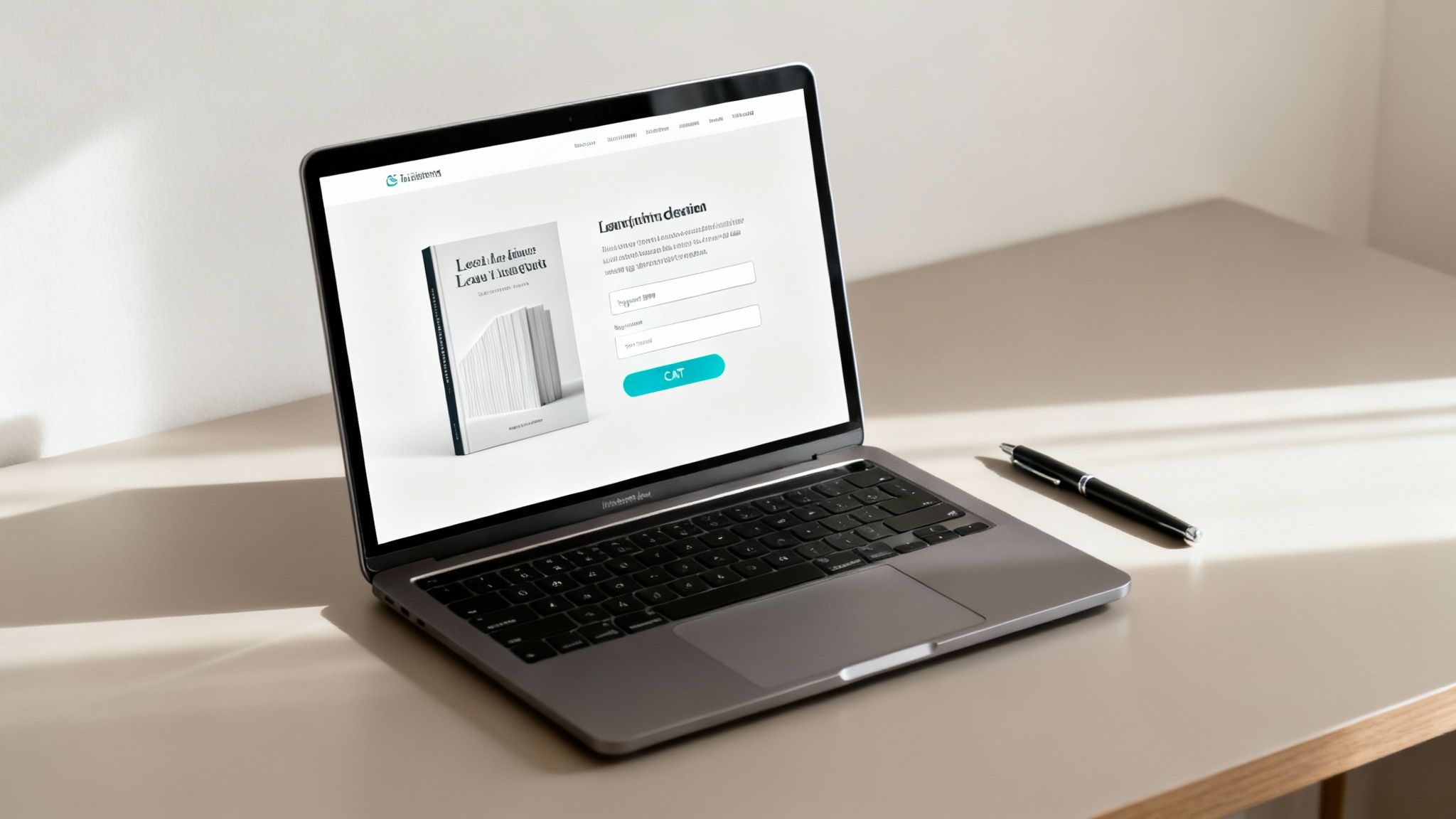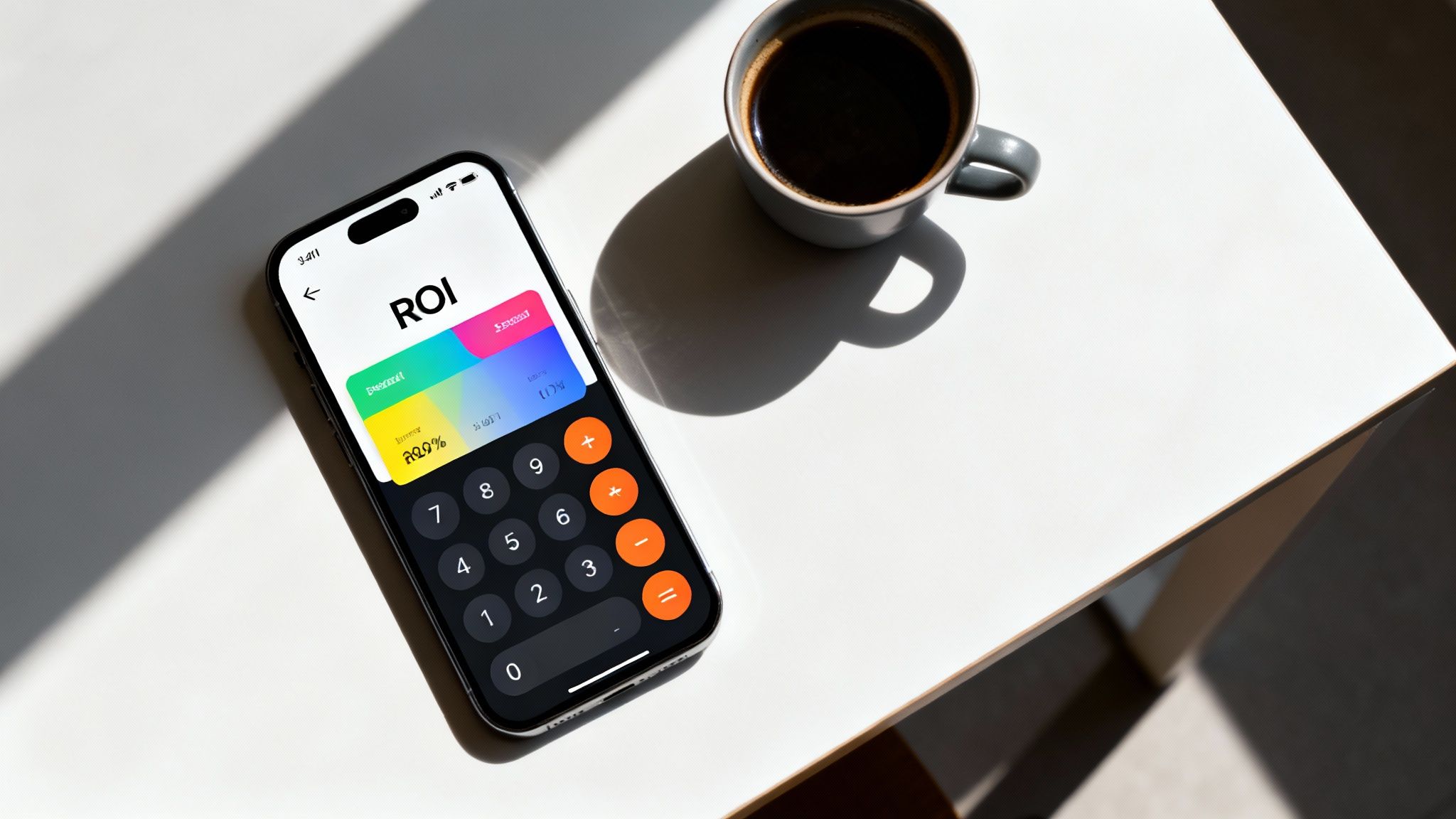In today's competitive market, attracting, engaging, and delighting customers requires more than traditional advertising. It demands a strategic, value-driven approach known as inbound marketing. This methodology focuses on creating valuable content and experiences tailored to your audience, drawing them in naturally rather than interrupting them with unwanted messages.
But what does this look like in practice? To bridge the gap between theory and execution, we've compiled a list of powerful inbound marketing examples from innovative companies across B2B SaaS, professional services, and eCommerce. This isn't just a showcase of success stories; it's a strategic breakdown designed for action.
Inside, you will find a detailed analysis of each campaign, covering:
- The primary business goals and objectives.
- Specific channels and tactics used, from SEO and lead magnets to email nurturing.
- The measurable KPIs that defined success.
- CRM integration notes for platforms like Salesforce and Dynamics 365.
- A step-by-step guide to help you replicate their methods.
We'll dissect the "how" and "why" behind each strategy, offering tactical insights and actionable takeaways. Whether you're a marketing director at a professional services firm or leading growth for an MSP, these examples provide a replicable blueprint for building a marketing engine that drives sustainable client acquisition and growth. Let’s dive in.
1. Blog Content Marketing
Blog content marketing is the cornerstone of many successful inbound marketing examples. It involves creating and publishing valuable, relevant, and consistent blog articles to attract and retain a clearly defined audience. By addressing the specific pain points and questions of your ideal customer, you draw qualified organic traffic directly to your website.
This strategy positions your brand as a trusted authority and industry thought leader. Instead of interrupting prospects with ads, you provide solutions they are actively searching for, building trust from the very first interaction. This foundational approach fuels nearly every other inbound channel, from social media to email nurturing.
Strategic Breakdown
- Campaign Summary: The core goal is to produce a steady stream of high-quality blog content that ranks on search engines for keywords your target audience uses. This content serves as the entry point to your inbound funnel.
- Channels & Tactics: Primarily uses SEO (keyword research, on-page optimization) and Content Creation. It’s often amplified through Email Marketing (sending new posts to subscribers) and Social Media to broaden its reach.
- Success Story: HubSpot’s blog is a masterclass in this approach. They've built an empire by creating comprehensive articles, guides, and templates covering every conceivable marketing, sales, and service topic. This strategy attracts millions of monthly visitors, who are then converted into leads via strategically placed CTAs for lead magnets like ebooks and webinars.
How to Replicate This Strategy
- Identify Core Topics: Use tools like Ahrefs or Semrush to find long-tail keywords with high search intent but lower competition. Focus on problems your product or service solves.
- Create Pillar Pages & Topic Clusters: Develop comprehensive "pillar" guides on broad topics and support them with shorter, more specific "cluster" posts that link back to the main page. This structure signals topical authority to Google.
- Optimize & Promote: Ensure every post is optimized for on-page SEO (meta titles, headers, image alt text). Promote new content to your email list and social media followers to generate initial traffic and social signals. For more details on the fundamentals, explore what blogging is and how it works in digital marketing.
- Update and Refresh: Regularly update older posts with new information, data, and internal links to maintain their relevance and search rankings.
2. Lead Magnets and Gated Content
Lead magnets and gated content are a fundamental tactic for transforming anonymous website visitors into identifiable leads. This strategy involves offering a high-value resource—such as an ebook, whitepaper, checklist, or webinar—in exchange for a user's contact information. Instead of just attracting traffic, you're creating a direct value exchange that initiates a deeper relationship.
This method is one of the most effective inbound marketing examples for lead generation because it provides an immediate solution to a specific problem. By offering targeted expertise, you capture the details of prospects who are actively seeking help, allowing you to segment and nurture them based on their interests. This is the critical bridge between the "Attract" and "Convert" stages of the inbound methodology.

Strategic Breakdown
- Campaign Summary: The goal is to convert website traffic into marketing-qualified leads (MQLs) by offering premium content behind a form. This content directly addresses a prospect's pain point and demonstrates your brand's expertise.
- Channels & Tactics: Primarily uses Content Creation (the magnet itself), Landing Pages (to host the offer), and Email Marketing (for lead nurturing follow-ups). These offers are often promoted via CTAs within blog posts, on social media, and through paid amplification.
- Success Story: Salesforce excels at this with its extensive library of whitepapers and reports, such as its annual "State of Sales" report. They offer deep, data-driven industry insights that B2B professionals need to stay competitive. In exchange for an email address, users get a valuable asset, and Salesforce gets a highly qualified lead to enroll in a targeted CRM nurture sequence.
How to Replicate This Strategy
- Identify a High-Value Offer: Analyze your blog's top-performing content or use keyword research to find a specific, urgent problem your audience faces. Create a resource that provides a tangible solution, like a template, checklist, or data-rich report.
- Build a High-Converting Landing Page: Create a dedicated landing page with a clear headline, concise bullet points explaining the benefits of the offer, and a short form. The page should be distraction-free, focusing solely on the conversion action. For a detailed guide, see how to optimize landing pages for better conversion.
- Create an Automated Follow-Up Sequence: Once a user submits the form, immediately deliver the promised asset via email. Follow this with a series of 3-5 automated emails that offer additional related resources, build trust, and gently guide the lead toward a sales conversation.
- Promote Your Lead Magnet: Place compelling CTAs for your lead magnet within relevant blog posts, on your homepage, and in your website's header or footer. Share the landing page across your social media channels to drive targeted traffic.
3. Search Engine Optimization (SEO)
Search Engine Optimization (SEO) is the non-negotiable engine behind the best inbound marketing examples. It is the practice of optimizing your website’s content, technical structure, and authority to rank higher on search engine results pages (SERPs) like Google. When executed correctly, SEO attracts a continuous stream of highly qualified visitors who are actively searching for your solutions.
This strategy is fundamental because it captures demand at its source. Rather than pushing a message out, you pull prospects in by being the most relevant answer to their questions. A strong SEO presence establishes credibility, drives consistent lead flow, and reduces long-term reliance on paid advertising, making it a high-ROI inbound pillar.
Strategic Breakdown
- Campaign Summary: The goal is to achieve high organic rankings for valuable keywords related to your products or services. This involves on-page optimization, technical site health, and off-page authority building to make your website the preferred choice for search engines.
- Channels & Tactics: SEO is a multi-faceted channel combining Content Creation (targeting search intent), Technical SEO (site speed, mobile-friendliness, structured data), and Link Building (acquiring backlinks from reputable sites). It works in tandem with nearly all other inbound efforts.
- Success Story: Ahrefs exemplifies product-led SEO mastery. They create world-class educational content and free tools that their target audience of SEOs and marketers actively seeks. This content ranks for thousands of high-value keywords, driving organic traffic that naturally converts into users of their paid platform, proving their tool's value by using it to succeed.
How to Replicate This Strategy
- Conduct a Technical SEO Audit: Use tools like Screaming Frog or the Ahrefs Site Audit tool to identify and fix foundational issues like broken links, slow page speed, and crawl errors. A healthy site is the price of entry for ranking.
- Align Content with Search Intent: Move beyond just keywords. Analyze the top-ranking pages for your target queries to understand what users really want. Are they looking for a guide, a tool, a list, or a direct answer?
- Build Topical Authority: Structure your content into topic clusters. Create a comprehensive "pillar" page for a broad topic and surround it with "cluster" posts that cover specific sub-topics in detail, all interlinking to signal your expertise to Google. To learn more, explore the fundamentals of what search engine optimization is and how it works.
- Acquire High-Quality Backlinks: Develop a strategy for earning links from authoritative websites in your industry. This can include digital PR, guest posting, or creating link-worthy original research and data-driven content.
4. Email Marketing and Nurture Sequences
Email marketing and nurture sequences are the engine of relationship-building in inbound marketing. This strategy involves sending a series of automated, targeted emails to guide leads through the buyer's journey after they've converted on a lead magnet or shown initial interest. It moves beyond one-off blasts to deliver valuable content at the right time, building trust and keeping your brand top-of-mind.
This approach is one of the most effective inbound marketing examples for converting leads into customers. By segmenting your audience and personalizing content, you transform cold leads into warm prospects who are educated, engaged, and ready to buy. It's the critical link between attracting a visitor and closing a sale.
Strategic Breakdown
- Campaign Summary: The goal is to develop automated email workflows (nurture sequences) that trigger based on a user's actions, such as downloading an ebook. Each email in the sequence provides further value and gently guides the prospect toward a decision.
- Channels & Tactics: Primarily uses Email Marketing automation platforms. It relies heavily on Segmentation (based on lead data in your CRM) and Content Creation (repurposing blogs, case studies, and webinar invites for the emails).
- Success Story: ConvertKit excels at this with its creator-focused campaigns. When a new user signs up for a free guide on growing a newsletter, they don't just get the guide. They are entered into a nurture sequence that shares success stories from other creators, monetization tips, and tutorials on using ConvertKit's features—all designed to move them from a free user to a paying customer.
How to Replicate This Strategy
- Map the Buyer's Journey: Define the awareness, consideration, and decision stages for your audience. Assign specific content pieces (blog posts, case studies, comparison guides) that align with each stage.
- Segment Your Audience: Use your CRM to segment contacts based on their initial conversion point, industry, job title, or on-site behavior. This ensures your emails are highly relevant.
- Build Your Workflow: In your email automation tool, create a sequence of 3-5 emails. The first should deliver the promised lead magnet, while subsequent emails should address common questions, overcome objections, and highlight your solution's benefits. For more insights, explore how to build a winning email marketing campaign.
- Analyze and Optimize: Track key metrics like open rates, click-through rates, and unsubscribe rates. Use A/B testing on subject lines and CTAs to continually improve the performance of your nurture sequences.
5. Video Marketing and YouTube Content
Video marketing has become an indispensable component of modern inbound strategies. This approach involves creating and distributing valuable, engaging video content to attract, educate, and convert a target audience. From short-form social clips to in-depth YouTube tutorials, video captures attention in a way that text and static images cannot, making it a powerful medium for storytelling and building brand affinity.
By addressing audience pain points, showcasing product value, or providing industry insights through a visual medium, brands can build trust and authority. Video content is highly shareable and effective across the entire marketing funnel, from generating top-of-funnel awareness on YouTube to driving bottom-of-funnel decisions with detailed product demonstrations.

Strategic Breakdown
- Campaign Summary: The objective is to produce a consistent stream of video content that addresses specific audience needs and ranks on platforms like YouTube and Google. This content acts as a powerful magnet for qualified traffic, driving viewers back to owned web properties.
- Channels & Tactics: This strategy heavily relies on YouTube as a primary channel, supported by SEO for video optimization. Tactics include creating tutorials, expert interviews, and product explainers. Content is amplified through Social Media (embedding videos in posts) and Email Marketing (sharing new videos with subscribers).
- Success Story: Wistia, a B2B video hosting platform, excels at this. They use their own platform to create high-quality, engaging content about video marketing itself, from creating compelling explainer videos to shooting with a simple DSLR. Their friendly, educational approach not only showcases their product's capabilities but also positions them as the go-to experts in the video marketing space, attracting their ideal customer base.
How to Replicate This Strategy
- Define Your Video Pillars: Identify core topics your audience cares about that align with your expertise. Plan a content series around these pillars, such as a "how-to" series, an "ask the expert" segment, or customer success stories.
- Optimize for Discovery: Treat YouTube as a search engine. Conduct keyword research for video topics and optimize titles, descriptions, and tags. Create compelling custom thumbnails that encourage clicks.
- Integrate CTAs: Embed clear calls-to-action within your videos. These can be verbal cues or on-screen graphics that direct viewers to a landing page, a related blog post, or a free trial.
- Promote and Repurpose: Share your video across all channels. Repurpose the content by transcribing it into a blog post, pulling out key quotes for social media graphics, or creating short clips for platforms like Instagram Reels or LinkedIn. To dive deeper, you can find a guide on YouTube SEO and how to skyrocket your views.
6. Social Media Content and Community Engagement
Social media content and community engagement transform passive followers into active brand advocates. This inbound marketing example involves creating and sharing content tailored to specific platforms to foster conversations, build relationships, and nurture a loyal community. Instead of broadcasting sales messages, brands provide value through entertainment, education, and genuine interaction.
This approach builds brand personality and humanizes your business, making it more relatable and trustworthy. By actively participating in conversations and encouraging user-generated content, you create a vibrant ecosystem that attracts new followers organically. This strategy supports the entire inbound funnel by driving top-of-funnel awareness and guiding engaged users toward your website and other conversion points.
Strategic Breakdown
- Campaign Summary: The goal is to build an active, engaged community on relevant social platforms by consistently publishing valuable content and participating in authentic conversations. This cultivates brand loyalty and drives referral traffic.
- Channels & Tactics: This strategy primarily leverages Social Media Marketing (content creation, scheduling, community management) and Content Creation (visuals, videos, copy). It’s often integrated with Blogging (sharing articles) and Customer Service (addressing inquiries).
- Success Story: Glossier's community-driven strategy is a powerful example. They masterfully leverage user-generated content (UGC) by reposting customer photos and testimonials on platforms like Instagram. This not only provides an endless stream of authentic social proof but also makes their customers feel seen and valued, strengthening the community bond and encouraging others to participate.
How to Replicate This Strategy
- Define Your Platform Strategy: Identify which social media channels your ideal customers frequent. Tailor your content format and tone for each one; what works on LinkedIn (professional insights) will differ from what works on Instagram (visual storytelling).
- Establish a Content Mix: Plan a content calendar that balances different types of posts: educational (tips, how-tos), entertaining (memes, behind-the-scenes), and promotional (product features, offers). A common rule of thumb is the 80/20 rule: 80% value-driven content and 20% promotional.
- Prioritize Engagement: Actively respond to comments, direct messages, and brand mentions. Ask questions in your captions to encourage conversation and make your audience part of the dialogue.
- Encourage User-Generated Content: Create a branded hashtag and run campaigns that incentivize customers to share their experiences with your product or service. Highlighting UGC is one of the most effective forms of social proof.
7. Webinars and Live Events
Webinars and live events serve as powerful, high-value inbound marketing examples that foster direct engagement with a target audience. This strategy involves hosting live or on-demand online presentations to educate, demonstrate value, and build authority on a specific subject, generating highly qualified leads in the process.
By offering a deep-dive into a topic your audience cares about, you create a compelling reason for them to exchange their contact information for access. This method is exceptionally effective for B2B SaaS and professional services firms, as it allows for real-time interaction, Q&A sessions, and a more personal connection than static content, moving prospects down the funnel faster.
Strategic Breakdown
- Campaign Summary: The objective is to attract a relevant audience to a live or recorded digital event by promoting high-value, educational content. The registration process captures lead data directly, which is then entered into a CRM for sales follow-up and long-term nurturing.
- Channels & Tactics: Primary tactics include Email Marketing (invitations to subscriber lists), Paid Social (targeting specific job titles and interests on platforms like LinkedIn), and Content Marketing (using blog posts and landing pages to promote the event). The event itself is a form of content delivery.
- Success Story: Salesforce is a prime example, regularly hosting webinars featuring industry experts and thought leaders. Their "Salesforce Live" events cover topics from AI integration in CRM to specific industry challenges. By offering valuable insights from trusted voices, they attract thousands of decision-makers, who register and become warm leads integrated directly into their own Salesforce CRM for immediate sales team engagement.
How to Replicate This Strategy
- Select a Niche Topic: Choose a specific, compelling problem your audience faces. Instead of a broad topic like "Marketing Tips," try something focused like "5 Underutilized LinkedIn Ad Strategies to Triple B2B Leads."
- Promote Across Channels: Create a dedicated landing page and promote the webinar at least two to three weeks in advance via email, social media, and a banner on your website. Use paid ads to reach new, targeted audiences.
- Engage and Follow Up: During the webinar, use polls and Q&A to keep the audience engaged. Afterward, send the recording to all registrants and segment the attendee list for targeted follow-up nurturing sequences based on their engagement.
- Repurpose the Content: Turn the webinar recording into a blog post, create social media clips from key moments, and use attendee questions to inspire future content ideas, maximizing the ROI of a single event.
8. Infographics and Visual Content
Infographics and other forms of visual content condense complex information into easily digestible and highly shareable graphics. They excel at capturing attention in a crowded digital landscape, making them a powerful tool for attracting top-of-funnel traffic and building brand authority. This is one of the most effective inbound marketing examples for generating backlinks and social shares.
By transforming dense data or complex ideas into compelling visual narratives, you cater to how modern audiences prefer to consume information. This strategy not only enhances understanding and retention but also positions your brand as a helpful, data-driven resource, encouraging organic distribution as others share your valuable content across their own channels.
Strategic Breakdown
- Campaign Summary: The goal is to create branded, visually appealing infographics based on original research, industry data, or complex processes. These assets are designed to be embedded in blog posts and shared widely on social media to generate traffic, backlinks, and brand awareness.
- Channels & Tactics: Primarily leverages Content Creation (design and data visualization) and SEO (earning backlinks from other sites that use the graphic). It is amplified through Social Media Marketing (especially on visual platforms like Pinterest and LinkedIn) and Blogger Outreach to encourage sharing.
- Success Story: WordStream has mastered this tactic by producing numerous infographics on digital marketing topics, like their "PPC Statistics" or "Cost Per Lead" visuals. These graphics distill vast amounts of data into clean, understandable charts and figures. As a result, they are frequently cited by other marketing blogs, earning high-quality backlinks that boost WordStream’s domain authority and search rankings.
How to Replicate This Strategy
- Identify a Compelling Data Story: Gather original data, survey results, or compile compelling industry statistics that tell a clear story. Focus on topics that answer common questions or reveal surprising trends within your niche.
- Design for Clarity and Brand Consistency: Use tools like Canva or Piktochart to design a clean, uncluttered infographic. Ensure it incorporates your brand colors, logo, and a clear title. Make the data the hero of the visual.
- Optimize for Sharing and SEO: Create an accompanying blog post to host the infographic. Include a "share" button and an embed code to make it easy for others to use on their sites. Optimize the post’s meta title, description, and image alt text for relevant keywords.
- Promote Extensively: Share the infographic across all your social media channels. Reach out to industry bloggers, journalists, and partners who might find the data valuable for their own content, offering them the graphic as a resource.
9. Customer Testimonials and Case Studies
Customer testimonials and case studies are powerful inbound marketing examples that leverage social proof to build trust and credibility. They transform satisfied customers into brand advocates, showcasing real-world success and demonstrating the tangible value of your product or service. This approach is especially effective for prospects in the consideration and decision stages of the buyer's journey.
By presenting authentic stories, you allow potential customers to see themselves in the success of others, making your solution feel more relatable and less risky. These assets provide concrete evidence that your offerings deliver on their promises, moving beyond marketing claims to showcase proven results and building a strong foundation of trust that accelerates the sales cycle.
Strategic Breakdown
- Campaign Summary: The objective is to systematically collect, produce, and distribute compelling customer success stories. These assets are used across the marketing funnel to validate your product’s effectiveness, overcome objections, and provide social proof to prospects.
- Channels & Tactics: Primarily involves Content Creation (written case studies, video testimonials) and Website Optimization (placing them on key conversion pages). They are amplified through Email Marketing (nurture sequences), Social Media (quote graphics, video clips), and Sales Enablement (arming sales teams with relevant stories).
- Success Story: Salesforce is a prime example, with its extensive library of customer stories filterable by industry, company size, and product. They present detailed narratives complete with specific challenges, solutions, and impressive, data-backed results. This turns their customer base into a powerful, persuasive marketing asset that speaks directly to the needs of different audience segments.
How to Replicate This Strategy
- Identify Ideal Candidates: Work with your sales and customer success teams to identify clients who have achieved significant, measurable results and are enthusiastic about your brand.
- Structure the Narrative: Frame the story around the classic problem-solution-result model. Clearly outline the customer's initial challenge, how your product was implemented to solve it, and the specific, quantifiable outcomes they achieved (e.g., "35% increase in lead conversion").
- Choose the Right Format: Create in-depth written case studies for your website and sales team. Repurpose these into more digestible formats like video testimonials, short quote graphics for social media, and one-page summaries.
- Distribute Strategically: Feature testimonials prominently on your homepage, pricing pages, and dedicated landing pages. Integrate case studies into lead-nurturing email sequences to address common pain points and build confidence over time.
10. Interactive Tools and Calculators
Interactive tools and calculators offer a high-value exchange that goes beyond static content. By providing a utility that helps users solve a specific problem, such as calculating potential ROI or assessing their current performance, you deliver immediate, personalized value. This active engagement makes prospects more receptive to sharing their information in return for detailed results.

This inbound marketing example excels at capturing leads who are actively evaluating a solution, placing them further down the consideration funnel. Instead of just telling a prospect they can save money or improve efficiency, a calculator proves it with their own data, building immense credibility and trust.
Strategic Breakdown
- Campaign Summary: The goal is to develop and promote a free, interactive tool that solves a common pain point for the target audience. The tool acts as a powerful lead magnet, gating the full results behind an email submission form to capture highly qualified leads.
- Channels & Tactics: Primarily leverages Content Creation (building the tool itself) and Landing Pages. It is promoted heavily via SEO (ranking for "calculator" or "assessment" keywords), Paid Social, and Email Marketing to drive traffic and usage.
- Success Story: HubSpot’s suite of free tools, particularly their Website Grader, is a prime example. Users enter their website URL and email to receive a detailed performance report. This simple exchange has generated millions of leads for HubSpot, providing their sales team with valuable context about a prospect's needs before the first conversation even begins.
How to Replicate This Strategy
- Identify a Key Metric: Determine a crucial calculation or assessment your audience needs to make. This could be a profit margin calculator for eCommerce, a social media ROI calculator, or an A/B test significance calculator.
- Develop the Tool: Use no-code platforms like Outgrow or involve developers to build a simple, intuitive tool. Focus on a clean user interface and ensure the calculations are accurate and genuinely helpful.
- Create a High-Converting Landing Page: Design a dedicated landing page that clearly explains the tool's benefits. Gate the detailed results behind a short form to capture lead information.
- Promote Across Channels: Feature the tool prominently on your homepage, write blog posts about the problems it solves, run paid ads targeting relevant audiences, and share it with your email subscribers.
10 Inbound Marketing Examples Compared
Turning Inspiration Into Action: Your Inbound Marketing Blueprint
The journey through these diverse inbound marketing examples reveals a powerful, unifying principle: successful inbound strategies are built on a foundation of genuine value. Whether it's HubSpot's comprehensive blog content or a professional services firm's insightful webinar, the goal is always to attract, engage, and delight an audience by solving their problems—not just selling them a product.
We've seen how B2B SaaS companies leverage in-depth lead magnets and how eCommerce brands build communities through compelling social media content. Each example reinforces that inbound is not a collection of isolated tactics but a deeply integrated ecosystem. SEO drives discovery, content provides answers, lead magnets capture intent, and email nurturing builds relationships. This synergy is what transforms a casual visitor into a loyal customer.
From Observation to Implementation
The most critical step is translating inspiration into a tangible plan for your own business. It's easy to feel overwhelmed by the possibilities. The key is to start small, be strategic, and build momentum.
- Identify Your Core Challenge: What is the single biggest question or pain point your ideal customer faces? Your first inbound initiative should directly address this.
- Select a Foundational Tactic: Don't try to launch ten initiatives at once. Choose one high-impact tactic from the examples, such as creating a pillar blog post or developing a high-value lead magnet.
- Define Success Metrics: Before you begin, determine your KPIs. Is it lead generation, email subscribers, or demo requests? Clear goals are essential for measuring impact and proving ROI.
The most successful campaigns we analyzed were not one-off efforts but part of a sustained commitment. They consistently created and distributed valuable content, analyzed performance data, and iterated on their approach. This data-driven mindset is non-negotiable.
The Technology Backbone of Inbound Success
A recurring theme across these high-performing inbound marketing examples is the strategic use of technology. A well-configured CRM, such as Salesforce or Dynamics 365, is the central nervous system of any modern inbound strategy. It allows you to:
- Track the Full Customer Journey: Understand every touchpoint a prospect has with your brand, from their first blog visit to their final purchase.
- Implement Sophisticated Nurturing: Automate personalized email sequences based on user behavior and lead scores.
- Prove Marketing ROI: Connect marketing activities directly to sales outcomes, providing clear attribution and justifying budget allocation.
Without this technological integration, even the best content can fail to convert. Your efforts become siloed, lead follow-up is inconsistent, and measuring true impact is nearly impossible. The examples demonstrate that a seamless flow of data between your marketing automation platform and your CRM is what elevates a good strategy to a great one.
Ultimately, the power of inbound marketing lies in its customer-centric philosophy. By shifting your focus from interruption to attraction, you build trust, establish authority, and create a sustainable engine for growth. Use the strategies detailed in this article not as a rigid rulebook, but as a blueprint to architect a unique inbound machine that drives measurable results for your business. The journey starts now.
Ready to move from inspiration to implementation? The expert team at Twelverays specializes in building and executing sophisticated inbound marketing strategies, including seamless CRM integration with platforms like Dynamics 365. Visit Twelverays to see how we can help you build an inbound engine that delivers predictable, scalable growth.





